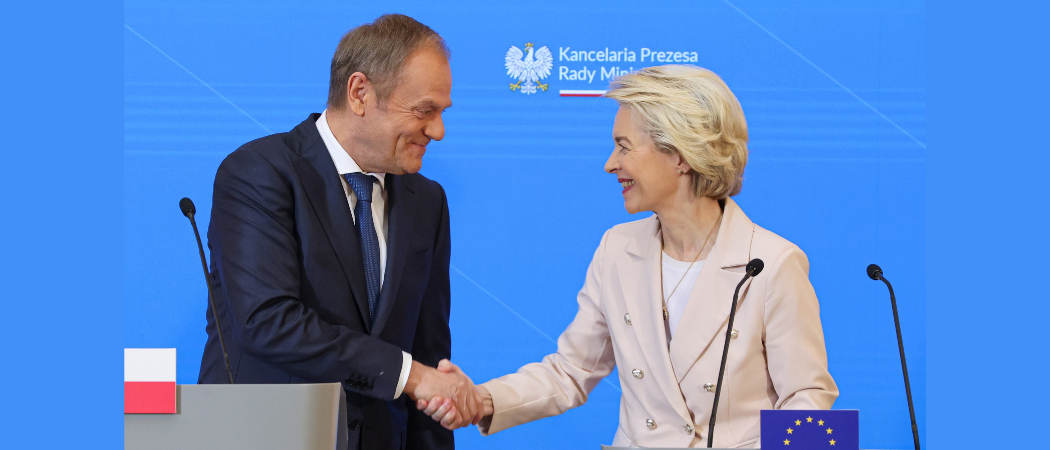Reform of Poland’s judiciary has opened access to long-delayed EU payments and sparked hopes of increased R&D funding. But experts say there is now a need for long-term planning and a strategic use of resources

Polish Prime Minister Donald Tusk, whose government has been behind reforms that led to the EU unfreezing frozen funds, shakes hands with European Commission President Ursula von der Leyen. Photo: Christophe Licoppe / European Union
The unfreezing of up to €137 billion in EU funds following reforms in Poland is an opportunity to increase investment and confidence in the country’s innovation ecosystem, but the money must be backed up by strategic planning, say key stakeholders.
The move marks the end of a long-standing dispute between Poland and the EU over reform of the judiciary, which caused a two-year delay in accessing the funds and raised concerns among the academics about the impact on investment in research and innovation.
The country will receive €60 billion from the Recovery and Resilience Facility set up to help countries recover from the pandemic and transition to greener energy sources, and up to €76.5 billion from the 2021–2027 cohesion funds, which aim to narrow the gap between richer and poorer EU regions.
Although the long-awaited funding sparked hopes for new investment in research and innovation, researchers question whether Poland well be able to use these resources wisely to support innovative projects and collaboration between industry and academia.
Katarzyna Walczyk-Matuszyk, vice president of the Polish Chamber of Commerce for High Technology, described the €137 billion as, “an unprecedented chance to boost Polish research and innovation investment” and to increase Poland’s standing in science and technology within the EU and beyond. The money could be particularly important for fields including robotics and artificial intelligence.
“The so far unfavourably low level of research and development investment in the business sector, which was associated with the low share of this sector in R&D expenditure in the country, is gradually changing,” Walczyk-Matuszyk said. She noted the share of R&D expenditure in relation to GDP in Poland has increased by 0.2 percentage points due to cohesion funding.
Krzysztof Głowacki, an analyst at the think tank WiseEuropa, said €60 billion would make it possible to invest in areas including health, digitisation, modernising insulation of buildings, and electric mobility. Investment in green technologies is important for Poland, which is still dependent on coal and has low energy efficient buildings.
At the same time, the funds are likely to stimulate private investment, offering more co-financing options and greater control over capital engagement for potential investors.
For example, the European Funds for Smart Economy 2021-2027 (EFSE), the first national programme for the implementation of the cohesion policy in Poland approved by the EU, aims to bolster research and innovation through €7.9 billion in grants and mixed funding opportunities. However, only about 3% is allocated directly to the research sector, according to Walczyk-Matuszyk. This includes initiatives like the International Research Agendas programmes, which focus on centres of excellence, and funding for the Teaming for Excellence initiative in Horizon Europe.
Stimulating innovation
The Commission’s acknowledgment that Poland now respects the rule of law increases confidence in the country overall and raises its international attractiveness. Głowacki said this will have a favorable effect on the entire economy, but it is particularly significant for the R&D sector, because of its high capital intensity and exposure to significant risks.
But despite positive mood music, merely transferring resources is not sufficient to stimulate innovation. “Moving eggs from one basket to another does not on its own imply that we are be able to cook ourselves a delicious omelette,” Głowacki said. Poland needs a smart set of rules to leverage domestic and international funds, and in addition to upholding the rule of law, must ensure cohesion funds are allocated to the most promising projects.
“These EU funds are in theory supposed to target high innovation projects, but are in practice more often used for regular investments with little to no innovative footprint,” Głowacki said.
Evaluating the fallout from the two-year delay in accessing the funding, Głowacki said based on WiseEuropa’s audit, the most innovative private entities were not significantly affected by the delay, because they tend to prefer market financing rather than relying on the public funds. However, regional and local authorities were forced to take out loans because they had to finance public utility projects that could not be postponed.
Walczyk-Matuszyk said that a large number of applications, and uncertainties about the EU’s decision on releasing the funds, have led to delays in assessing project proposals. “Delays in evaluation directly affect the results of these projects, especially if the innovation is proposed by an SME,” she said.
There is also a pressing need for strategic long term planning, leveraging synergies, and enhancing technological priorities, Walczyk-Matuszyk said. In addition, the corruption scandal over the fast-track grants disbursed by national research funding agency National Centre for Research and Development (NCBR) in 2022, had affected the public trust in the system, she said.
NCBR supports two aspects of Poland's National Recovery and Resilience plan: Resilience and competitiveness of the economy, and Digital Transformation. The first helps entrepreneurs implement circular economy principles in their business. “The project may also finance investments in R&D infrastructure used to develop technologies for the use of waste as a secondary raw material,” NCBR told Science|Business.
The Digital Transformation component aims to strengthen the cyber resilience of information systems, which includes the IPCEI Next Generation Cloud Infrastructure and Services project which has a budget of PLN 448.2 million (€104.5 million).
Despite concerns over effective distribution of funds, hopes for advancing innovation in Poland remain high. “The societal expectation regarding the launch of funds for Poland has been enormous from the very beginning. I believe we were all aware of the immense economic challenges if this did not happen,” Walczyk-Matuszyk said.
The Ministry of Funds and Regional Policy did not respond to a request for comment.





 A unique international forum for public research organisations and companies to connect their external engagement with strategic interests around their R&D system.
A unique international forum for public research organisations and companies to connect their external engagement with strategic interests around their R&D system.